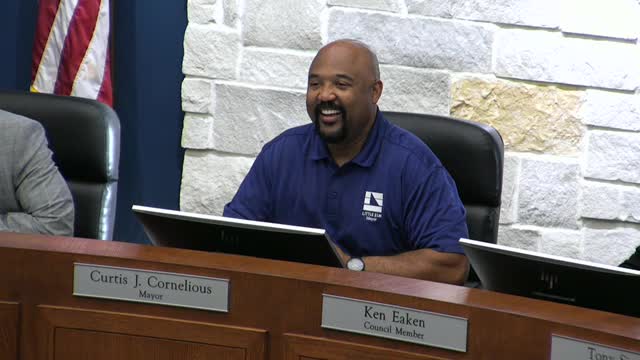Little Elm fire marshal proposes 2024 International Fire Code adoption; highlights lithium‑ion, school egress and sprinkler changes
October 21, 2025 | Little Elm, Denton County, Texas
This article was created by AI summarizing key points discussed. AI makes mistakes, so for full details and context, please refer to the video of the full meeting. Please report any errors so we can fix them. Report an error »

James Connor, fire marshal for the Town of Little Elm, told council the town staff recommends switching from the town’s 2018 fire code to the 2024 International Fire Code and discussed specific local amendments and implementation considerations.
"We're going to switch over to the 2024 international fire code," Connor said, adding that the update aligns Little Elm with neighboring North Texas jurisdictions and with the International Building Code and other model codes. He said the town has not updated its fire code since 2018 and is "about three editions behind." Connor said the North Central Texas Council of Governments assisted with a regional amendment process to promote consistency across cities.
Connor said the largest new public‑safety change for Little Elm addresses lithium‑ion batteries and energy storage: the proposed code clarifies where energy storage and vehicle charging stations can be located, whether remote emergency shutoffs are required and limits on locating charging near occupied buildings. "A big one that we added this year is gonna be lithium ion batteries and energy storage," he said, and described the hazard as heat release with limited venting in confined spaces.
Other changes Connor outlined: Group E occupancies (classrooms and similar educational spaces) would be required to demonstrate two ways out of each classroom during inspection and drills; the town would work with school districts to implement twice‑a‑year checks. He said minimum standards for water distribution piping would be adjusted in some contexts from 12 inches to 8 inches to lower infrastructure costs while meeting flow requirements. Connor also proposed lowering the threshold for requiring full automatic sprinkler systems in self‑storage buildings from 5,000 square feet to 3,000 square feet and adding a requirement that occupancies with sprinkler systems add fire‑alarm notification strobes when a building changes tenants if those alarms are not already present.
Connor said the updates would help maintain the town’s Insurance Services Office (ISO) Class 1 rating and align the town with Texas best practices. He said staff worked with planning, building, engineering and community integrity departments and with area fire marshal offices to craft the recommended amendments.
Council members asked implementation questions, including whether the fire code provisions would address EV charging at private residences (Connor said those matters are primarily covered by the building code but that the fire code addresses proximity to buildings and multi‑unit situations) and whether the classroom egress rule would require structural renovation (Connor said it would generally require updated maps and drills rather than immediate structural changes). Connor closed by noting staff will bring the amendments back on a future council agenda for formal adoption.
The presentation was made during the Oct. 22, 2025 workshop; no ordinance was adopted at the meeting and the item will return for formal consideration.
"We're going to switch over to the 2024 international fire code," Connor said, adding that the update aligns Little Elm with neighboring North Texas jurisdictions and with the International Building Code and other model codes. He said the town has not updated its fire code since 2018 and is "about three editions behind." Connor said the North Central Texas Council of Governments assisted with a regional amendment process to promote consistency across cities.
Connor said the largest new public‑safety change for Little Elm addresses lithium‑ion batteries and energy storage: the proposed code clarifies where energy storage and vehicle charging stations can be located, whether remote emergency shutoffs are required and limits on locating charging near occupied buildings. "A big one that we added this year is gonna be lithium ion batteries and energy storage," he said, and described the hazard as heat release with limited venting in confined spaces.
Other changes Connor outlined: Group E occupancies (classrooms and similar educational spaces) would be required to demonstrate two ways out of each classroom during inspection and drills; the town would work with school districts to implement twice‑a‑year checks. He said minimum standards for water distribution piping would be adjusted in some contexts from 12 inches to 8 inches to lower infrastructure costs while meeting flow requirements. Connor also proposed lowering the threshold for requiring full automatic sprinkler systems in self‑storage buildings from 5,000 square feet to 3,000 square feet and adding a requirement that occupancies with sprinkler systems add fire‑alarm notification strobes when a building changes tenants if those alarms are not already present.
Connor said the updates would help maintain the town’s Insurance Services Office (ISO) Class 1 rating and align the town with Texas best practices. He said staff worked with planning, building, engineering and community integrity departments and with area fire marshal offices to craft the recommended amendments.
Council members asked implementation questions, including whether the fire code provisions would address EV charging at private residences (Connor said those matters are primarily covered by the building code but that the fire code addresses proximity to buildings and multi‑unit situations) and whether the classroom egress rule would require structural renovation (Connor said it would generally require updated maps and drills rather than immediate structural changes). Connor closed by noting staff will bring the amendments back on a future council agenda for formal adoption.
The presentation was made during the Oct. 22, 2025 workshop; no ordinance was adopted at the meeting and the item will return for formal consideration.
View full meeting
This article is based on a recent meeting—watch the full video and explore the complete transcript for deeper insights into the discussion.
View full meeting
